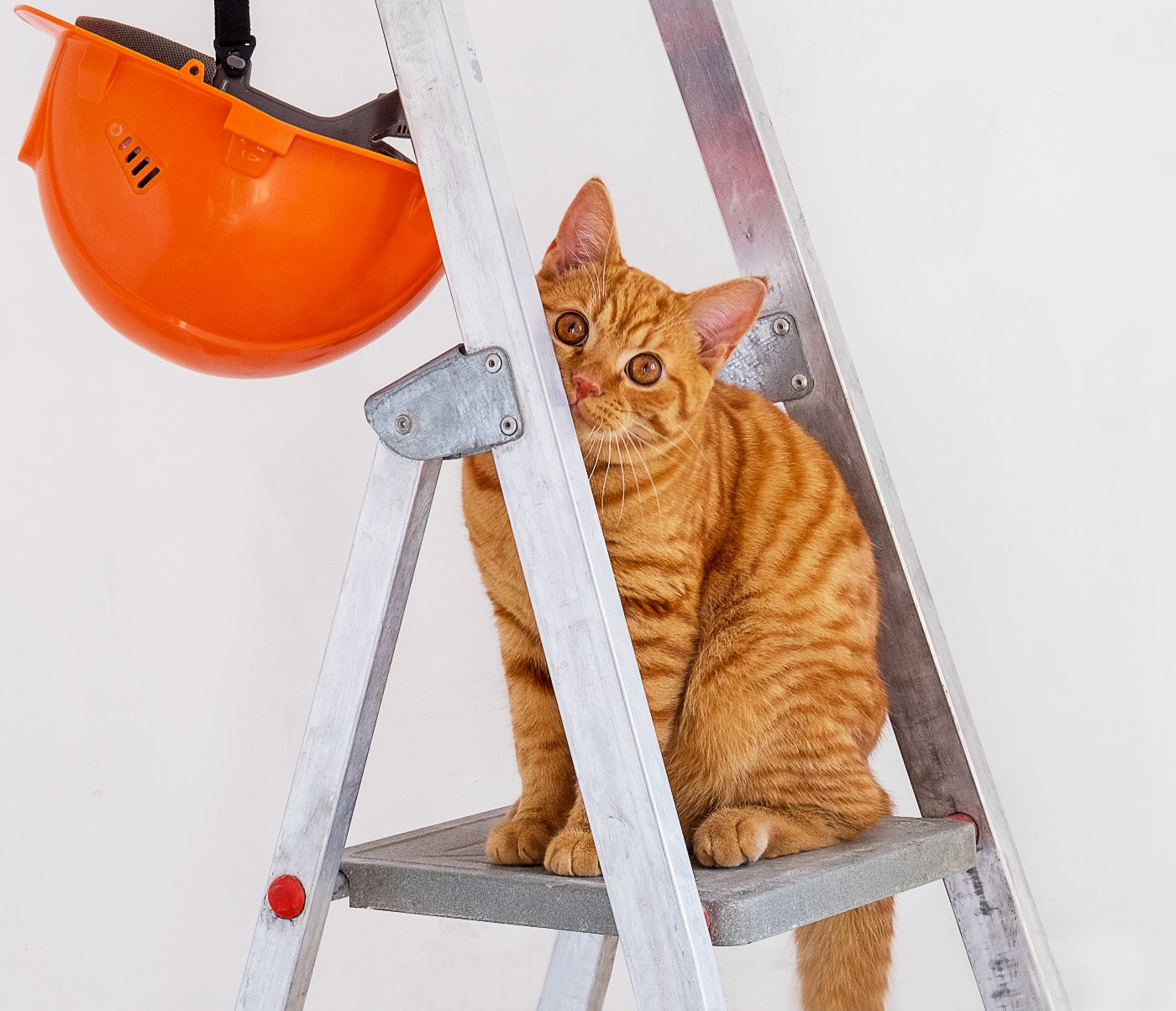Remodeling and redecorating is a big trend this year, with spending more time at home in the office, or saving money by entertaining at home. Thanks for considering your kitties in your plans!
Territory is very important to cats, so changes in their environment can be stressful. Most cats prefer their own people family to strangers, so bringing workers into your house can feel like a home invasion to your cats.

Cats can also easily get lost during a building project. They can become so frightened they run outside to get away from the noise. Workers have other goals besides watching out for family pets and sometimes leave doors or windows open.
You can keep down their stress by including them in your plans…and this works for the canine members of your family too! If your remodel is minor, here are two tips to help you weather the project. If it’s extensive and longer than a couple of months, you might consider boarding them or finding a familiar and safe friend or relative for them to stay with.
Safe & Sound
The first step is to make sure they feel safe, especially if they’re shy.
If your cats already have a Safe Room where they retreat when scared, start there. If they don’t, consider creating a new Safe Room as far away from the construction as possible.
The Safe Room needs to feel very secure and include everything they need to stay there all day. Add at least one litterbox per cat (keeping their regular ones in place if the remodel is minor), set up food and water stations and make sure they have nests with familiar bedding to tuck into.
Offer them extra hiding places by draping a chair, adding beds behind furniture or better yet, adding boxes. You know how most cats love boxes! Toys, a little catnip and food puzzles will help make it enticing. If you normally keep a closet closed, open that door for them too.

It’s a bonus if you can do some soundproofing. Construction can be noisy and seemingly random, especially with power tools and loud generators. Cat hearing is far more acute than ours, so imagine turning up the volume by 3 on any construction noise and you’ll feel why they get so scared.
Add soft materials, like more rugs and pillows. Move bulky furniture where the noise is, if possible. If you have a portable clothing rack, you can hang some clothes against the noisy wall. Draw the curtains or hang blankets in the window, unless that adds stress for them to not see outside.
Cats still need their regular family time, so before construction starts, work spending time in their Safe Room into your routine. Work on your laptop or stream your shows there. Set a daily playtime…or two. Feed them there at the same time every day.
If they are used to you being in with them daily, they should be less concerned when you start to shut the door daily too.
Along with your devices for shows or music, play white noise every day. Most smart phones come with a white noise app, or you can get a device just for that. This is great for canceling out construction noise when that ramps up later.

When it’s time for actual construction to start, label the door with a big sign that says “DO NOT ENTER.” If you think that might be missed, use barricade tape to seal the door when you leave.
Giving them a place of safety helps you monitor them. You’ll want to do a head count at least twice a day to make sure everyone is accounted for.
If you can let them back out at night, do a construction check before you do. Look for holes in the wall that might be big enough for a cat (did you know most cats can fit through a space as small as 4 inches wide?) and make sure those are sealed.
Remove or cover for any sharp materials such as fasteners or wire. Make sure all paints and stains are dry and cans are covered. Vacuum drywall dust before your cats track it.

Stranger Danger
The second step is to ease their fear of unfamiliar humans. Allowing strangers inside to make big, noisy changes to their most familiar spaces can feel like a home invasion.
If you have outgoing cats who like hanging out with strangers, you may still need to confine them to keep them out of construction dangers and mess rather than lowering stress. Cats like that may need more space and less hiding than shy cats.

If they are curious and want to observe, you might consider installing a temporary screen door at their room or wherever they can stay safe but still be a part of the process.
For shy kitties, try making your work crew more familiar. Invite the people involved to plan at your home so you can introduce your cats ahead of time. Ask the crew to play with your cats and give them treats to share.
Share a meal so they don’t feel like complete strangers. Getting to know your crew better may make the process less stressful for you too!
Dr Dodman of Tufts University points out that remodeling is one of the top 10 reasons a cat can have litterbox issues. In reality, it’s not the litterbox, it’s anxiety over having their territory suddenly and drastically changed. Their instinct is to defend their space, and that could include marking foreign scents and materials.

If that happens, be proactive. Clean and neutralize the spots immediately with a strong urine neutralizer like Anti-Icky-Poo (silly name, effective product!). Continue to monitor for that throughout the project.
If the remodeling is relatively minor, allowing your cats to reclaim their spaces when the workers leave on weekends may help them adjust. They’ll be able to mark appropriately by rubbing on new surfaces rather than spraying them.
However, if your cats show you they are scared by staying hidden, wait until the project is completed before letting them out. Once the remodeling is done, you will probably be anxious to make the new space your own and so will they.
Place their familiar cat equipment like cat trees and nesting spots in the new spaces. Let the cats come out at their own pace.
Feed and play with them in the new spaces. Show them how happy you are to have your remodeled space and enjoy it with them!





